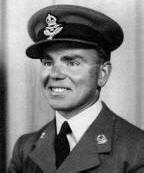 |
Hello! This is the voice of C.E.S!
You know – “Smithy”... “Old Smut” – that mild little man you
used to brush to one side as you raced down the School corridor.
No?
Very well then. That mixture of Attila the Hun, Genghis Kahn and
the Ogre from the top of the beanstalk! Please yourselves!
There is no cause for alarm, as those who saw me at the memorial
service for Alan Murray on 21 March 2005 in Purley would
realise. You just have to kick aside my walking stick and I’ll
be at your mercy.
However, I will now endeavour to clear up some misconceptions that
still seem to persist.
I was born on 16 Nov 1912 at Gosport, Hampshire; the son of a Royal
Marine. As such I was able to start my early “learning curve” at
a very good school where the headmaster and the deputy head were
captains of Marines, |
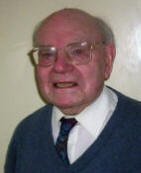 |
|
Flying Officer RAFVR,
Charles E. Smith. |
Charles Edward Smith,
March, 2005, aged 92 |
|
and the staff were
sergeants and corporals. I believe that it was during
this early schooling in the military education system
that I caught onto the idea that ORDERS WERE TO BE
OBEYED!!
Growing up in Portsmouth
Passing the “11 Plus” enabled me to go to Gosport Grammar School. I
soon learnt that Hampshire IS the county for cricket! As a schoolboy, I used to attend Fratton Park (the home of
Portsmouth FC) on a Saturday afternoon to watch and cheer Pompey
to many a victory. Some years later, this was reflected in the
little sailor news cut-out that used to appear each Monday
morning on my classroom notice board – indicating if Pompey had
won, lost or drawn.
Together with five of my colleagues from King Alfred’s College of
Winchester (on advice from our Senior Tutor) we applied for
teaching posts to the Croydon Education Committee. All of us
were accepted and three of us remained with Croydon Education
for the whole of our teaching careers.
Was it lack of ambition or job satisfaction that we stayed for so
long? For me the latter.
It was in Croydon at my very first appointment during September
1934 to Ingram Road School, Thornton Heath, that I met Mr.
William Cracknell. It was to become a professional and family
association that lasted until his death in the year 2000.
The outbreak of war in 1939 meant the evacuation of the Ingram Road
School to Brighton. At that time there was no schooling as such
and our role as teachers was to keep contact with our pupils
either in the local Park or on a beach! After the evacuation of
military servicemen from Dunkirk, we were relocated to a school
near West Byfleet. As well as my teaching duties I was also
recruited as a Fire Watcher and Air Raid Warden during Air
Raids.
It will undoubtedly be a real surprise to all who have known me
over the years, to learn that I failed my application for Active
Service because of incipient leg trouble discovered when I was
called up for military service with the RAF.
Joining JRCS at Tamworth Road
In 1941 I was instructed by my employers (Croydon Education
Committee) to return to Croydon and to join the staff at John
Ruskin Central School in Tamworth Road where, to my great
pleasure, I rediscovered Mr. William Cracknell already a
well-established member of staff.
In a reference given to me by Mr. McLeod in 1948, he writes “...
Mr. C. E. Smith joined my Staff primarily as an Instructor in
Physical Training... But I found that I had also gained a
class-master of the highest quality in Mathematics and Religious
Knowledge."
I have been everlastingly grateful for the wonderful good fortune
that led me to the appointment at John Ruskin.
The popular belief when I joined
the school - and it appears to be prevalent since - was that I
had been a Physical Training Instructor/PTI in the Royal Navy, a
belief that was completely unfounded! At no time have I ever
been in the Navy.
However, unbeknown to anyone at John Ruskin, Tamworth Road, I had
joined the RAF Volunteer Reserve with the rank of Pilot Officer
and subsequently as a Flying Officer.
During 1943-45 I served with three other officers at the 79th
Squadron ATC based at St Joseph’s College, Upper Norwood, as a
teacher of Basic Mathematics and Air Navigation and, with the
aid of large scale maps of the Eastern Approaches, the art of
Pathfinding by plotting Air Speed, Ground Speed and Wind Speed.
The Squadron had a regular Sunday morning Parade in the College
grounds each week. Little did I know that many years later - in
1980 - I would be on the teaching staff at St. Josephs College in
Beulah Hill, Croydon.
On August 6 1945 I was at an RAF base near Weston-Super-Mare when I
heard a Tannoy announcement declaring that the Atom Bomb had
been dropped on Hiroshima; an event in history that will forever
be remembered. It did not just herald the ending of the war
against Japan; it was the beginning of a dangerous new era for
the world.
When I joined the staff of John Ruskin Central School in September
1942 as P.E. and maths teacher it was traditionally a soccer
playing school but with very few sports facilities. There was
only a small, hard surfaced playground between the building and
wall alongside the road outside. However, a short bus ride, or
more often than not a walk, would take us to the foot of Duppas
Hill where we had a football pitch and a small hutment with a
single changing room. At one end was a storage section for the
grounds man’s machinery and, at “our” end, a sink with a
cold-water tap.
Like most other things during the war, sporting equipment was
nearly impossible to purchase and very hard to obtain even from
the closest of contacts. A couple of soccer balls and a few
unmatched team shirts were all that we had to our name. (See
Peter Oxlade's 2nd X1 photo of 1943-44
below for a view of
the team shirts, socks of various colours, and the heavy-toed
football boots.)
There was a strong soccer tradition at Ruskin and within the
Schools’ Football League in the Borough of Croydon. I continued
what had clearly been the norm prior to 1939. After the war,
when John Ruskin became a Grammar school, it was felt by some
that rugby should become the recognised sport and that soccer
should be dropped. Many a debate took place on this subject and,
in the end, it was Mr. Lowe who, after listening to all the
arguments, decided that the school tradition of playing soccer
should be maintained.
I was very happy with the headmaster’s decision to continue the
school’s football tradition since 1920. It was now a question of
finding opponents available for inter-school matches.
Our intake at Ruskin was from boys who had passed the 11-plus in
Croydon Schools. Those who were less fortunate and did not pass
were educated in various other Senior Schools in the Borough of
Croydon, which meant that there was an immediate supply of
football playing opponents locally. Gradually, as travelling
became easier in that post war era, I was able to extend
fixtures to neighbouring locations in Sutton, Cheam, Epsom,
Woking, Guildford, Bromley and Upper Norwood.
It took years of patient building and expansion to successfully
produce the full cricket and football fixture lists that we had
until my retirement.
During my many years at John Ruskin, I served on the Croydon
Schools Cricket and Football Committees and the Surrey Schools
Committee. I travelled as an associate member of the English
schools cricket teams to grounds such as Old Trafford,
Edgbaston, St Helens, Swansea, the Oval and the home of Cricket
– Lords; and enjoyed every minute of it.
The Windmill - Tamworth Road to
Shirley Hills
In 1955 the school was moved from
Tamworth Road to a new, purpose-built school with a
“countryside” outlook in the Shirley Hills. This represented a
marked transformation for students and staff. At last, we had
space and a sensational outlook.
The building had well appointed classrooms, science and art rooms,
an assembly hall with a professional stage and a REAL gymnasium
for ME to teach in.
However, there was one criticism of the new site layout. The
kitchens and dining hall were adjacent to the main entrance of
the school and did nothing to enhance a positive first
impression for visitors.
I am sure that one of the things that pupils will remember is my
insistence that full respect would be given to all the furniture
and fittings in my care. When I left in 1978 the furniture was
left by me in pristine condition.
There was a generous playground on one side of the building and on
the other, beyond a preserved ancient Windmill, there was a
piece of ground available for sports opportunities. For the
first time in the school’s history we had all of this, together
with a playing field complete with a Pavilion located off Oaks
Road (a few hundred yards walk from the rear exit of the
school). This certainly represented a vast improvement on the
facilities previously enjoyed at Duppas Hill when the school was
in its Tamworth Road location.
As sports master, there were inevitably times when I was called to
the telephone (no extension lines or mobiles in those days) to
consult with other schools regarding the arrangement of sports
fixtures, etc. In view of this, it was agreed that I should be
based in Room 1, the nearest to the school office and its
telephone! One of the bonuses of being in Room 1 was that I had
an excellent daily view of the Windmill – so I feel I can truly
claim to be a very early “Friend of the J. R. Windmill!” Within
the windmill itself the ground floor space provided an adequate
area for the storage of cricket nets, practice hurdles and other
equipment associated with the sports function.
One other bonus for being in Shirley, as opposed to Tamworth Road,
was that during games periods I was able to arrange for a small
group of the Fifth and Sixth forms to use the tennis courts at
the Shirley Sports Club, and other sporting facilities readily
available in the local vicinity.
The nearby Shirley Hills provided us with a ready made natural
cross country jogging circuit. It did not take long to recognise
not only how decidedly better it was at Shirley, but also to be
aware of the miracles that both staff and students at Tamworth
Road had worked to achieve such high standard in both work and
sport in the conditions that existed there.
When I look back over the many years that I spent at John Ruskin, I
feel a warm glow of gladness and gratitude. To have worked with
so many excellent professional people for such a long period was
a great joy. I will remember the many of our students for the
high standards that they achieved in both academic and sporting
activities.
After 36 years at the school...
In 1977, I reached my retirement age with a mixture of
fulfillment
and sadness, tinged with disappointment that my leaving date
would be before a group of our students took their examinations.
Thus, it was with great delight that I received the news that
the Education Committee had agreed that I should stay on until
those exams had been completed.
With sadness in my heart, I said my fond farewells to colleagues
and students in the summer of 1978.
I consider that it was a real privilege to have had the opportunity
of teaching at John Ruskin, and I cherish my memories of that
rewarding and happy time. I am very grateful to all those people
who contributed towards it.
Like many others who reach the time when the daily tasks of a
lifetime suddenly disappear and the unfamiliar time on one’s
hands takes over, I was pleased to be approached by other local
educational establishments in the private sector to work for
them in a teaching capacity on a short- term contract basis.
I had the pleasure of working for St. Anne’s College, St. Joseph’s
College and Croydon High School until I finally decided to
exchange my chalk sticks for a walking stick and a quieter life.
I joined a Bowling Club, a Walking Club and an Art Group, as
well as becoming a Steward at the Fairfield Halls in Croydon.
So that mixture of Attila the Hun, Ghengis Khan or the Ogre at the
top of the beanstalk finally bowed out into full retirement in
1992.
Charles E. Smith, Croydon, February 2007.
Included here is a collection of
archive images kindly provided by Charles Smith, who served as
PE and mathematics master at John Ruskin Central and Grammar
School from 1942 until his retirement from the school staff in July 1978. Click on
any thumbnail to view a
larger image.
Incidentally, The Royal Air Force Volunteer Reserve/RAFVR
was formed in July 1936 to supplement the Auxiliary Air
Force/AAF, which had been established in 1925 by the local
Territorial Associations. Initially the RAFVR was composed of
civilians recruited from the neighbourhoods of Reserve Flying
Schools, which were run by civilian contractors who largely
employed as instructors members of the Reserve of Air Force
Officers/RAFO. Navigation instructors were mainly former master
mariners without any air experience. Recruits were confined to
men between 18 and 25 who had been accepted for part-time
training as pilots, observers and wireless operators. The object
was to provide a reserve of aircrew for use in the event of war.
When war broke out in 1939 the Air Ministry employed RAFVR as
the principle means for aircrew entry to serve with the RAF. The
original RAFVR ceased to exist in 1954 when Reserve Flying
Schools were disbanded. [More] |
|
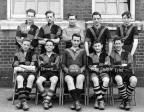 |
The 1943/44 School First XI
This
image was taken in the Tamworth Road school playground.
Top row: Bill Petty,
unknown,
Stevens,
unknown, Berty Parsons.
Bottom row: D. Hanbridge,
Len Brown,
unknown,
Peter Oxlade and Tyler.
|
 |
The 1943/44 School Second XI
This
image was taken in the Tamworth Road school playground - note the
size of those boots and the varied socks (Economy Britain!)
Top row: Gibb,
Dunbar,
unknown,
unknown,
unknown ,
unknown, unknown,
Pilcher.
Bottom row:
unknown,
Packham, McLuskey,
Peter Oxlade,
Warren
and Prockter, R.
|
 |
The 1945 School Cricket
Team
This
image was taken at the Tamworth Road school playground.
Top row: Mr. Charles E. Smith, Higgs (?), unknown,
unknown,
Bob Burton (?),
unknown, unknown, unknown, unknown.
Lower row: Warren, Brown, unknown, unknown, unknown, unknown,
McLusker, Packham.
|
 |
The 1949/50 School Second XI
This
image was taken in the Tamworth Road school playground.
Top row:
R. Montague, John Amos, Funnell, Banks, Jenkins, Baldwin,
Jackaman.
Bottom row:
Bainbridge, Dean, Sherman, Burnley, Morris.
|
 |
The JRGS 1950 School Soccer
Team
This
image was taken at the Duppas Hill Sports Ground.
From left-to-right: Dean, Montague, Amos,
unknown, Markrel,
unknown, Burt, Sherman
and Childs.
|
 |
The JRGS 1950 School Cricket
Team
This image was taken at the Duppas Hill Sports Ground.
Masters: Charles Smith (left) and Leonard Culcheth
(right).
Top row:
unknown,
Bishop, Arnold,
Duckworth, ,
unknown
and Dubyn.
Bottom row:
unknown, Martin,
Alan Montague,
Smith (?) and Stringer.
|
 |
The 1950/1951 League and Cup
winners
Corinthian Shield – Croydon
Schools Trophy
This image was taken at an
unknown location.
Top row: D. Lamb, Fred Evans, Harold Bailey, Johnny Birch and
Melvyn Williams.
Bottom: Fred Drain, Keith Baker, Ray Amos, Laurie Montague, Alan
Montague & Bob Constable. |
|
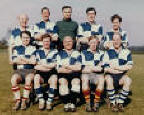 |
The JRGS Master's Football Team
This image was taken at the
Oaks Road Sports Ground in 1959/60.
Top row: Alan Murray, Sid
Bishop, Arthur Warne, Brian Cook and Anthony
Hasler.
Bottom row: J. N. Rhodes,
Neville Graham, Charles Smith, Martin Nunn and
Philip Robertshaw.
|
 |
The JRGS Master's Cricket
Team
The
image was taken at the Oaks Road Sports Ground (date
unknown).
Top row: Kenneth Tryon, Anthony
Hasler, Anthony Field, Philip Robertshaw, Martin Nunn, Dennis Dobson
and
Kenneth Cripps.
Bottom row: Desmond May, Brian
Cooke, John Lowe (Headmaster), Ronald Woodard, Neville Graham
and Charles Smith.
|
|
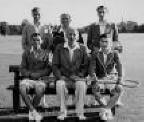 |
The JRGS Master's Tennis Team
This
image was taken at Shirley Sports Club (date
unknown).
Top row: G. M. Evans, Charles
Smith, D. Griffiths.
Bottom row: William Cracknell,
Leonard Chaundy, A. E. C. York. |
|
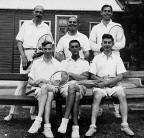 |
The JRGS Master's Tennis Team
This
image was taken at Shirley Sports Club (date
unknown).
Top row:
Leonard
Chaundy, Charles
Smith, George Manning.
Bottom row:
G. M. Evans, William Cracknell,
Alfred York.
|
|



